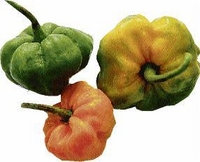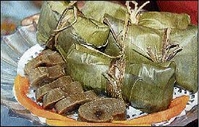Jamaican food:From Taino to Rasta
Published: Saturday | August 1, 2009

Scotch bonnet peppers, a must for lovers of spicy food.
'Emancipendence' is the time of year when our food comes into sharp focus. Our foods have made a leap over time to morph into a potpourri of flavours. When the Trelawny attraction, Outameni Experience, used the phrase 'from Taino to Rasta' to describe its motif, it served as a reminder of the journey of Jamaican cuisine. The diversity of Jamaican cuisine has, indeed, been shaped by circumstance, coincidence and hardship. It is a carnival of tastes and flavours, says the website Jamaica-insider.com.
Food Reference World Cuisine is equally effusive, describing Jamaican cuisine as "rich and spicy as the pepper-pot soup that originated with the Taino Indians". It continues: "Jamaican cooking draws from a brilliant interpretation of East Indian, Chinese, Spanish and British influences, all working harmoniously in a style that is uniquely Jamaican ... ."
Prior to the exploration of Jamaica by Christopher Columbus, the island was inhabited by natives of a West Indian tribe known as the Tainos. The word 'Taino' originated with Columbus and meant 'good' or 'noble. The Taino culture was highly developed in the Caribbean, so much so that, by the time Columbus arrived, there was tremendous creativity and energy.

earliest traditions
The Taino legacy is barbecue, an ancient tradition left to grace our cuisine today. The Taino diet relied heavily on vegetables, fruits, cassava, beans, barbecued meats and fish. Large animals were absent from their diet but smaller animals such as earthworms, lizards, beetles, birds and other mammals were caught.
Besides grilling, roasting and baking, the Tainos expanded cooking options to include a technique akin to jerking, which has become popular around the world. It is thought that jerk originated with the Maroons, descendants of the slaves who ran away from their Spanish slave masters to the mountains of Jamaica.
Meats are preserved by massaging it with a blend of natural seasonings such as peppers, scallion, thyme, pimento seeds and nutmeg - known now as jerk seasoning - and marinated for hours. Fish and meat were slowly roasted on a spit lined with pimento wood. Low heat and slow cooking retains the natural juices of the meat, which become infused with the flavour of the wood.
It has been said that the Maroons historically cooked underground to camouflage the smoke. Soups and stews were popular and it was out this group that the pepperpot soup emerged and is still popular today.
When Columbus claimed Jamaica for Spain, the Spanish brought pigs, goats and cattle, and so the island became a supplier of smoked and salted meat to Spanish ships en route to the Americas. Lard from the fat of animals was produced and exported. The Spanish introduced a number of fruit trees and plants such as the banana, plantain, sugar cane, Seville and Valencia oranges, coconut, tamarind, guinep and naseberry. The Spanish were fans of fried food and, as such, meals like escoveitched fish were developed. Other dishes introduced by the Spanish included oxtail and beans, stew peas and cow foot and beans.
The fight for the control of the island between the Spanish and English resulted in the lengthy colonisation of the island by the English. There was an influx of African slaves who brought a piece of their own culture through the preparation of food. The Africans have left us with dokunu, or tie leaf. Later, Indian indentured labourers came to Jamaica to work on sugar plantations. They brought small amounts of their spices which added to the cultural mix in the pot.
Curried goat, popular in today's cuisine, came here with the East Indians.
Chinese cooking was introduced to the island by indentured workers and Chinese merchants.
Ital cooking has been associated with Rastafarianism, a movement which revered former Ethiopian Emperor Haile Selassie I as a messiah who would return to save his people.
'Ital' is a variation on the word vital, essential to human existence. Ital, which has even made its way into the Oxford lexicon, is a way of preparing foods without the use of salt, meat, preservatives and colouring. Essentially, ital cooking uses ground provisions, peas, beans and nuts which are grown without fertilisers and other chemicals which speed the maturity of crops. On the occasion that animal protein is used, it may be fish or dried fish, not shellfish. Ital cooking is also considered vegetarian, focusing on the nutritive as well as the medicinal value of food.
The ital chef must be so versed that any vegetarian meals he/she prepares should be tasty, utilising a blend of herbs and spices. An important ingredient to tasty ital cooking is coconut milk, in which food is steeped. In addition to coconut milk, flavours come together from Scotch bonnet pepper, onions, scallion, thyme and pimento berries. The popular ital stew includes corn, beans, okra, carrots, garlic and coconut milk. Since no meat is used, the flavour is derived from the herbs and spices.
Run-down
2 coconuts, grated
3 stalks scallion, chopped
6 cups water
2lb pickled mackerel
3 tomatoes, chopped
2lb pickled mackerel
1 hot pepper, chopped and
deseeded
2 onions, chopped
3 sprigs thyme
1 clove garlic, chopped
Method
1. Soak the mackerel for at least three hours to remove excess salt, and remove bones. Set aside.
2. Add the water to the grated coconut and press the liquid through a sieve or grate in a blender. Set aside.
3. Boil the coconut milk rapidly in a heavy-bottom pot until reduced to curdled custard and oil.
4. Add the mackerel, cover and cook for 10 minutes over medium heat.
5. Stir in onion, garlic, scallion, tomatoes, hot pepper and thyme. Simmer for another 10 minutes over low heat.
6. Serve with boiled green bananas and cornmeal dumplings.
Serves 4.
Pickled red herring and bammies
2lb smoked red herring
2 hot peppers, chopped
1 onion, chopped
A few pimento berries
1/2 cup vinegar
Method
1. Remove skin from herring, discarding head and all the bones.
2. Shred the fish into small pieces.
3. Place in a bowl and add the chopped onion, vinegar, hot peppers and pimento. Mix well and bottle.
4. Serve on bammy rounds.

Dokunu, a Jamaican favourite.
